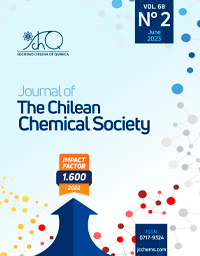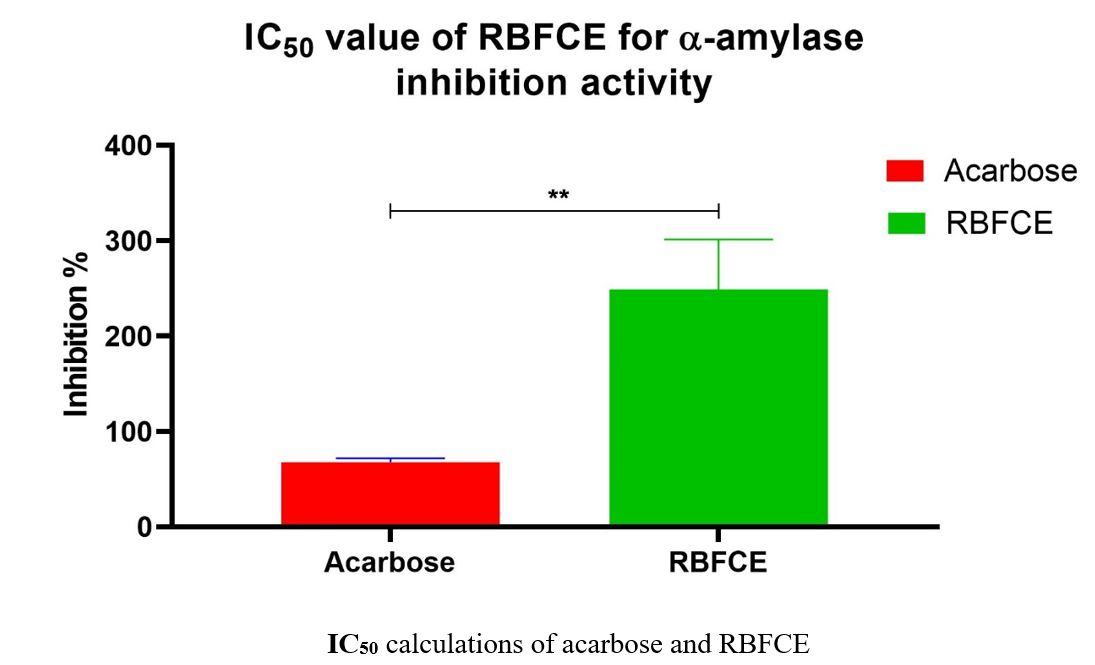ISOLATION, STRUCTURE ELUCIDATION & ANTIDIABETIC POTENTIAL OF ROSA BRUNONII L. FRUIT – FIGHT DIABETES WITH NATURAL REMEDIES

- Anti-diabetic activity, alpha-amylase inhibition activity, alpha-glucosidase inhibition activity, Rosa brunonii L. fruit, Catechin
Copyright (c) 2023 SChQ

This work is licensed under a Creative Commons Attribution-NonCommercial-ShareAlike 4.0 International License.
Abstract
Diabetes mellitus (DM) is a metabolic disorder that is marked by high blood glucose levels. Members of the Rosaceae family are a good source of antioxidants. Therefore, the current work sought to examine the potential for in-vitro alpha-amylase and alpha-glucosidase inhibition and the antidiabetic activity of Rosa brunonii L. fruit chloroform extract (RBFCE) against Alloxan (ALXN) induced diabetes in rats. RBFCE concentrations ranging from 20, 50, 100, 250, 500, and 750 g/mL were used in in-vitro activities, while oral doses of 500 mg/kg, 750 mg/kg, and 1000 mg/kg were given to rats in an in-vivo trial for 21 days. Isolation was carried out through column chromatography and modern spectroscopic techniques were used for characterization and structure elucidation. The isolated compound was identified as catechin. For alpha-amylase and alpha-glucosidase inhibition activity, RBFCE had IC50 values of 322.06±17.40 and 248.93±1.62, respectively. The IC50 values for acarbose against alpha-amylase and alpha-glucosidase inhibition were 64.64±3.70 and 67.60±4.20, respectively. RBFCE treatment regulated blood glucose levels dose-dependently over a 21-day study period. Histopathological studies revealed that RBFCE has recovered the damaged acinar structures to some extent in pancreatic tissue. Only focal tissue destruction observed. RBFCE treatment displayed normal glomeruli with no signs of inflammation, proliferation, necrosis, cipher of thyroidization and fibrosis. All the extract-treated groups had more protected pancreatic and kidney tissue than control group in dose-dependent manner. The current study results revealed that RBFCE had prominent alpha-amylase and alpha-glucosidase inhibition activity, regulates blood glucose level and normalize histopathological markers in diabetic rats compared to the negative control group.
References
- Saeedi, P., et al., WITHDRAWN: Global and regional diabetes prevalence estimates for 2019 and projections for 2030 and 2045: results from the International Diabetes Federation Diabetes Atlas. 2019: p. 107843.
- Meo, S.A., et al., Type 2 diabetes mellitus in Pakistan: Current prevalence and future forecast. 2016. 66(12): p. 1637-1642.
- Marathe, P.H., H.X. Gao, and K.L.J.J.o.d. Close, American D iabetes A ssociation S tandards of M edical C are in D iabetes 2017. 2017. 9(4): p. 320-324.
- Organization, W.H., Diabetes programme. 2012.
- David, J.A., et al., The Nrf2/Keap1/ARE pathway and oxidative stress as a therapeutic target in type II diabetes mellitus. 2017. 2017.
- Prasad, N., et al., To study the anti-hyperglycemic activity of porridge (A fibre rich dietary supplement) in management of type II diabetic subjects. 2018.
- Mancini, F.R., et al., Dietary antioxidant capacity and risk of type 2 diabetes in the large prospective E3N-EPIC cohort. Diabetologia, 2018. 61(2): p. 308-316.
- Opara, E.J.T.j.o.t.R.S.f.t.P.o.H., Oxidative stress, micronutrients, diabetes mellitus and its complications. 2002. 122(1): p. 28-34.
- Singh, R., et al., Role of free radical in atherosclerosis, diabetes and dyslipidaemia: larger‐than‐life. 2015. 31(2): p. 113-126.
- Montonen, J., et al., Dietary antioxidant intake and risk of type 2 diabetes. 2004. 27(2): p. 362-366.
- Ishaque, M., et al., Fruits of Rosa brunonii–A Source of Antioxidant Phenolic Compounds. Natural Product Communications, 2017. 12(11): p. 1934578X1701201106.
- Vincent, H.K., et al., Effects of antioxidant supplementation on insulin sensitivity, endothelial adhesion molecules, and oxidative stress in normal-weight and overweight young adults. Metabolism, 2009. 58(2): p. 254-262.
- McCue, P.P. and K. Shetty, Inhibitory effects of rosmarinic acid extracts on porcine pancreatic amylase in vitro. Asia Pacific Journal of Clinical Nutrition, 2004. 13(1).
- Pandithurai, M., et al., In vitro α-amylase and α-glucosidase inhibition activity of methanolic extract of marine brown alga Spatoglossum asperum. Int J Adv Pharm, 2015. 4(5): p. 83-87.
- Bräunlich, M., et al., Extracts, anthocyanins and procyanidins from Aronia melanocarpa as radical scavengers and enzyme inhibitors. Nutrients, 2013. 5(3): p. 663-678.
- Matsui, T., et al., In vitro survey of α-glucosidase inhibitory food components. Bioscience, biotechnology, and biochemistry, 1996. 60(12): p. 2019-2022.
- OECD, O., Guidance Document on Acute Oral Toxicity Testing. 2000, OECD, Paris, France.
- Sreejesh, P., B.H. Thampi, and E.J.I.J.o.P.S. Sreekumaran, Hypoglycaemic effect of glibenclamide: a critical study on the basis of creatinine and lipid peroxidation status of streptozotocin-induced diabetic rat. 2017. 79(5): p. 768-777.
- Nagappa, A., et al., Antidiabetic activity of Terminalia catappa Linn fruits. Journal of ethnopharmacology, 2003. 88(1): p. 45-50.
- Hye, M., et al., Isolation of (+)-catechin from Acacia catechu (Cutch Tree) by a convenient method. Journal of Scientific Research, 2009. 1(2): p. 300-305.
- Khavandi, K., et al., Strategies for preventing type 2 diabetes: an update for clinicians. Therapeutic advances in chronic disease, 2013. 4(5): p. 242-261.
- Lazalde-Ramos, B.P., et al., DNA and oxidative damages decrease after ingestion of folic acid in patients with type 2 diabetes. 2012. 43(6): p. 476-481.
- Moravej, H., et al., Complementary and alternative medicine to treat diabetes mellitus type 1 in Southern Iran. 2016. 41(1): p. 71-72.
- Azizi-Fini, I., M. Adib, and Z.J.E.J.I.M. Gharehboghlou, Herbal medicine use among patients with type 2 diabetes in Kashan, Iran. 2016. 22: p. 449-54.
- Ali-Shtayeh, M.S., R.M. Jamous, and R.M. Jamous, Complementary and alternative medicine use amongst Palestinian diabetic patients. Complementary Therapies in Clinical Practice, 2012. 18(1): p. 16-21.
- Argáez-López, N., et al., The use of complementary and alternative medicine therapies in type 2 diabetic patients in Mexico. Diabetes care, 2003. 26(8): p. 2470-2471.
- Balamurugan, E. and K. Ganesh, Prevalence and pattern of self medication use in coastal regions of South India. Br J Med Pract, 2011. 4(3): p. a428.
- Lourenço, S.C., M. Moldão-Martins, and V.D.J.M. Alves, Antioxidants of natural plant origins: From sources to food industry applications. 2019. 24(22): p. 4132.
- Penckofer, S., D. Schwertz, and K. Florczak, Oxidative stress and cardiovascular disease in type 2 diabetes: the role of antioxidants and pro-oxidants. Journal of Cardiovascular Nursing, 2002. 16(2): p. 68-85.
- Hamdan, I.I. and F.U. Afifi, Screening of Jordanian flora for α-amylase inhibitory activity. Pharmaceutical Biology, 2008. 46(10-11): p. 746-750.
- Vuong, Q.V., et al., Extraction and isolation of catechins from tea. Journal of Separation Science, 2010. 33(21): p. 3415-3428.
- Acharya, P.P., G.R. Genwali, and M. Rajbhandari, Isolation of catechin from acacia catechu willdenow estimation of total flavonoid content in camellia sinensis kuntze and camellia sinensis kuntze var. assamica collected from different geographical region and their antioxidant activities. Scientific World, 2013. 11(11): p. 32-36.
- Mrabti, H.N., et al., Separation, identification, and antidiabetic activity of catechin isolated from Arbutus unedo L. Plant roots. Plants, 2018. 7(2): p. 31.
- Dong, J.-J., et al., Isolation of antioxidant catechins from green tea and its decaffeination. Food and Bioproducts Processing, 2011. 89(1): p. 62-66.
- Kaur, G., et al., Isolation of Catechins from Roscoea purpurea. Journal of Young Pharmacists, 2020. 12(4): p. 389.
- Azad, A.K., K. Ogiyama, and T. Sassa, Isolation of (+)-catechin and a new polyphenolic compound in Bengal catechu. Journal of Wood Science, 2001. 47(5): p. 406-409.
- Kwik-Uribe, C. and R.M. Bektash, Cocoa flavanols: measurement, bioavailability and bioactivity. Asia Pacific Journal of Clinical Nutrition, 2008. 17.
- Barickman, T.C., D.A. Kopsell, and C.E. Sams, Selenium influences glucosinolate and isothiocyanates and increases sulfur uptake in Arabidopsis thaliana and rapid-cycling Brassica oleracea. Journal of agricultural and food chemistry, 2013. 61(1): p. 202-209.
- Cheng, G.W. and C.H. Crisosto, Browning potential, phenolic composition, and polyphenoloxidase activity of buffer extracts of peach and nectarine skin tissue. Journal of the American Society for Horticultural Science, 1995. 120(5): p. 835-838.
- Jacek Arct, B.B., K.P. Anna Oborska, and B.H.C. Poland, THE TEA ANO ITS COSMETIC APPLICATION. J. Appl Cosmetol, 2003. 21: p. 117-127.
- Lambert, J.D., et al., Inhibition of carcinogenesis by polyphenols: evidence from laboratory investigations. The American Journal of Clinical Nutrition, 2005. 81(1): p. 284S-291S.
- Yang, C.S., P. Maliakal, and X. Meng, Inhibition of carcinogenesis by tea. Annual review of pharmacology and toxicology, 2002. 42(1): p. 25-54.
- Xiao, H., et al., Green tea polyphenols inhibit colorectal aberrant crypt foci (ACF) formation and prevent oncogenic changes in dysplastic ACF in azoxymethane-treated F344 rats. Carcinogenesis, 2008. 29(1): p. 113-119.
- Fraga, C.G., et al., Basic biochemical mechanisms behind the health benefits of polyphenols. Molecular Aspects of Medicine, 2010. 31(6): p. 435-445.
- Fan, F.-Y., L.-X. Sang, and M. Jiang, Catechins and their therapeutic benefits to inflammatory bowel disease. Molecules, 2017. 22(3): p. 484.
- Velayutham, P., A. Babu, and D. Liu, Green tea catechins and cardiovascular health: an update. Current Medicinal Chemistry, 2008. 15(18): p. 1840.
- Galley, H.F. and N.R. Webster, Physiology of the endothelium. British Journal of Anaesthesia, 2004. 93(1): p. 105-113.
- Wild, S., et al., Global prevalence of diabetes: estimates for the year 2000 and projections for 2030. Diabetes Care, 2004. 27(5): p. 1047-1053.
- McIver, L.A. and J. Tripp, Acarbose. 2018.
- Rosak, C. and G. Mertes, Critical evaluation of the role of acarbose in the treatment of diabetes: patient considerations. Diabetes, metabolic syndrome and obesity: targets and therapy, 2012. 5: p. 357.
- Sen, S., et al., Hypoglycemic and hypolipidemic effect of Meyna spinosa leaves in high fat diet-alloxan induced type 2 diabetic rats. 2013. 8(2): p. 181-185.
- Ahmad, M., et al., Traditional herbal remedies used for the treatment of diabetes from district Attock (Pakistan). 2009. 41(6): p. 2777-82.
- Yeşilada, E., et al., Traditional medicine in Turkey IX:: Folk medicine in north-west Anatolia. 1999. 64(3): p. 195-210.
- Vianna, R., et al., In vivo anti-diabetic activity of the ethanolic crude extract of Sorbus decora CK Schneid.(Rosacea): a medicinal plant used by Canadian James Bay Cree nations to treat symptoms related to diabetes. 2011. 2011.
- Abdel-Hameed, E.-S.S., S.A. Bazaid, and M.S. Salman, Characterization of the phytochemical constituents of Taif rose and its antioxidant and anticancer activities. BioMed Research International, 2013. 2013.
- CierniaK, M.K.-D.a.J.J.o.F. and N. Research, Antioxidant and genoprotective properties of extracts from edible flowers. 2019. 58(1): p. 42-50.
- Middleton, E., C. Kandaswami, and T.C. Theoharides, The effects of plant flavonoids on mammalian cells: implications for inflammation, heart disease, and cancer. Pharmacological reviews, 2000. 52(4): p. 673-751.
- Ishaque, M., et al., Fruits of Rosa brunonii–A Source of Antioxidant Phenolic Compounds. 2017. 12(11): p. 1934578X1701201106.
- RAJENDIRAN, D., et al., A review on role of antioxidants in diabetes. 2018. 11(2): p. 48-53.


